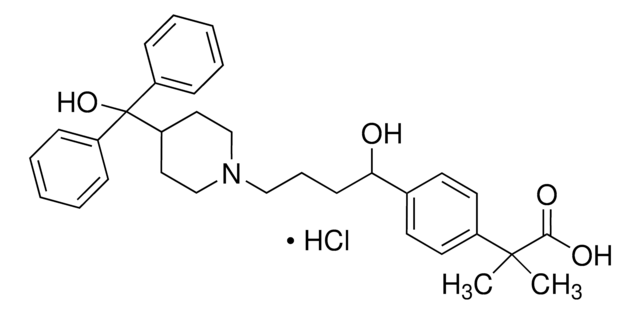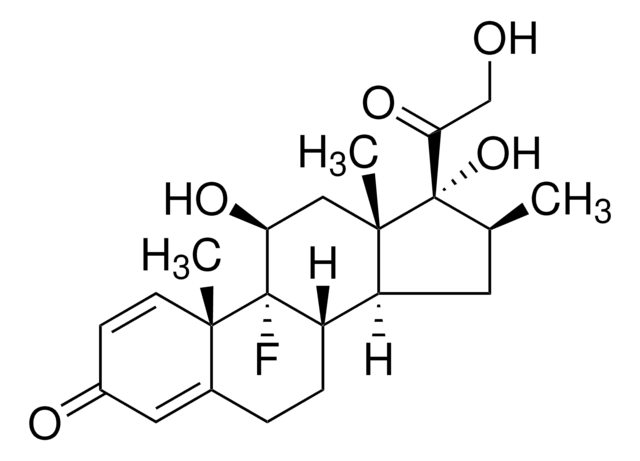Kluczowe dokumenty
1270377
USP
Fexofenadine hydrochloride
United States Pharmacopeia (USP) Reference Standard
Synonim(y):
Fexofenidine hydrochloride, MDL 16455 hydrochloride, Terfenidine carboxylate hydrochloride
About This Item
Polecane produkty
klasa czystości
pharmaceutical primary standard
rodzina API
fexofenadine
producent / nazwa handlowa
USP
Zastosowanie
pharmaceutical (small molecule)
Format
neat
ciąg SMILES
Cl[H].CC(C)(C(O)=O)c1ccc(cc1)C(O)CCCN2CCC(CC2)C(O)(c3ccccc3)c4ccccc4
InChI
1S/C32H39NO4.ClH/c1-31(2,30(35)36)25-17-15-24(16-18-25)29(34)14-9-21-33-22-19-28(20-23-33)32(37,26-10-5-3-6-11-26)27-12-7-4-8-13-27;/h3-8,10-13,15-18,28-29,34,37H,9,14,19-23H2,1-2H3,(H,35,36);1H
Klucz InChI
RRJFVPUCXDGFJB-UHFFFAOYSA-N
informacje o genach
human ... HRH1(3269)
Szukasz podobnych produktów? Odwiedź Przewodnik dotyczący porównywania produktów
Powiązane kategorie
Opis ogólny
Zastosowanie
- Fexofenadine Hydrochloride and Pseudoephedrine Hydrochloride Extended-Release Tablets
- Fexofenadine Hydrochloride Capsules
- Fexofenadine Hydrochloride Tablets
Działania biochem./fizjol.
Komentarz do analizy
Inne uwagi
produkt powiązany
Kod klasy składowania
11 - Combustible Solids
Klasa zagrożenia wodnego (WGK)
WGK 3
Temperatura zapłonu (°F)
Not applicable
Temperatura zapłonu (°C)
Not applicable
Wybierz jedną z najnowszych wersji:
Certyfikaty analizy (CoA)
Przepraszamy, ale COA dla tego produktu nie jest aktualnie dostępny online.
Proszę o kontakt, jeśli potrzebna jest pomoc Obsługa Klienta
Masz już ten produkt?
Dokumenty związane z niedawno zakupionymi produktami zostały zamieszczone w Bibliotece dokumentów.
Nasz zespół naukowców ma doświadczenie we wszystkich obszarach badań, w tym w naukach przyrodniczych, materiałoznawstwie, syntezie chemicznej, chromatografii, analityce i wielu innych dziedzinach.
Skontaktuj się z zespołem ds. pomocy technicznej


